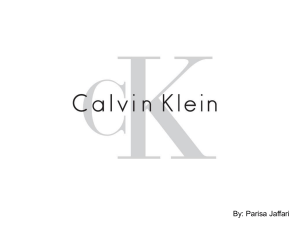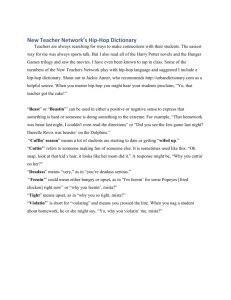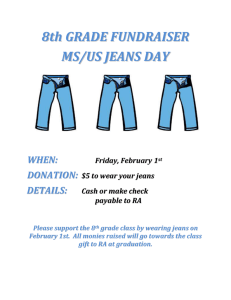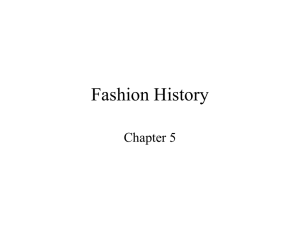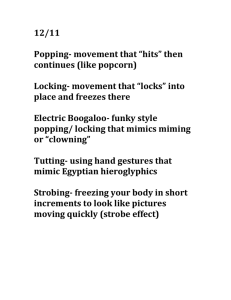August 31, 2004
advertisement
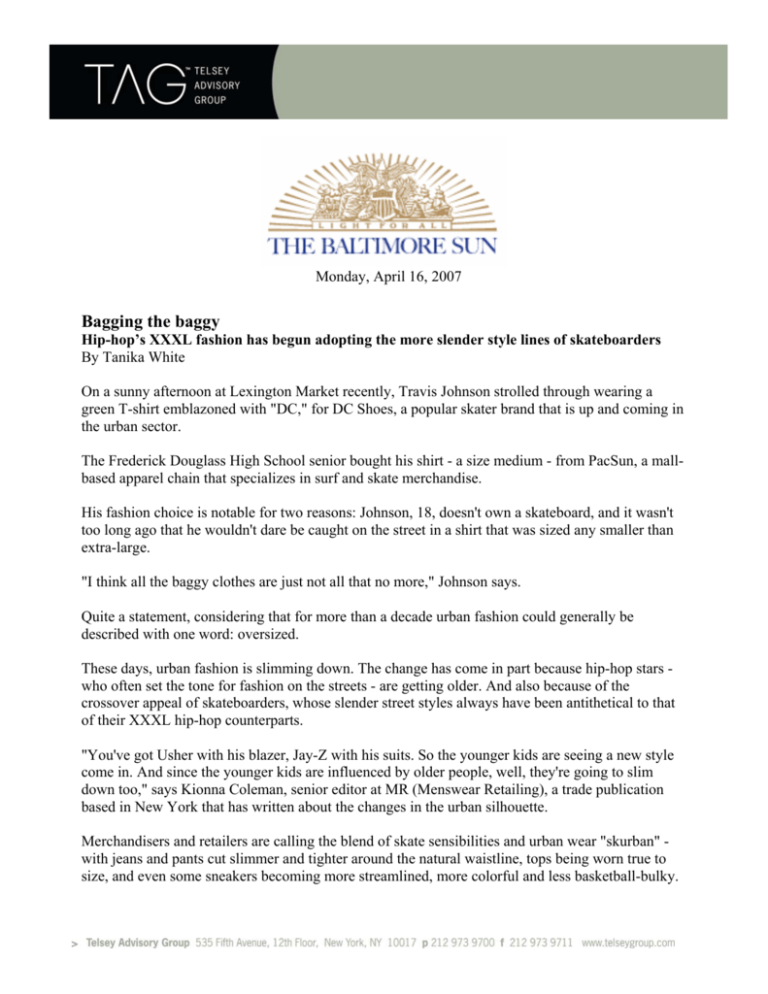
Monday, April 16, 2007 Bagging the baggy Hip-hop’s XXXL fashion has begun adopting the more slender style lines of skateboarders By Tanika White On a sunny afternoon at Lexington Market recently, Travis Johnson strolled through wearing a green T-shirt emblazoned with "DC," for DC Shoes, a popular skater brand that is up and coming in the urban sector. The Frederick Douglass High School senior bought his shirt - a size medium - from PacSun, a mallbased apparel chain that specializes in surf and skate merchandise. His fashion choice is notable for two reasons: Johnson, 18, doesn't own a skateboard, and it wasn't too long ago that he wouldn't dare be caught on the street in a shirt that was sized any smaller than extra-large. "I think all the baggy clothes are just not all that no more," Johnson says. Quite a statement, considering that for more than a decade urban fashion could generally be described with one word: oversized. These days, urban fashion is slimming down. The change has come in part because hip-hop stars who often set the tone for fashion on the streets - are getting older. And also because of the crossover appeal of skateboarders, whose slender street styles always have been antithetical to that of their XXXL hip-hop counterparts. "You've got Usher with his blazer, Jay-Z with his suits. So the younger kids are seeing a new style come in. And since the younger kids are influenced by older people, well, they're going to slim down too," says Kionna Coleman, senior editor at MR (Menswear Retailing), a trade publication based in New York that has written about the changes in the urban silhouette. Merchandisers and retailers are calling the blend of skate sensibilities and urban wear "skurban" with jeans and pants cut slimmer and tighter around the natural waistline, tops being worn true to size, and even some sneakers becoming more streamlined, more colorful and less basketball-bulky. The look is still a little loose, just not as ultra-baggy as before. "Customers are buying their clothes in a more true size," says Antonio Gray, apparel buyer for the region's DTLR (formerly Downtown Locker Room) stores. "So if they were in the past an extra large, they may have bought a 2x or 3x, because they wanted to exaggerate a look. But now they're wearing an extra large. By urban standards that's wearing your clothes smaller, but by other standards, it would be normal. This goes for pants too." The true-to-size looks are more evolution than revolution, experts say. "The hip-hop community continues to evolve, and I think that what people once thought of as being, almost iconoclastically, from the hip-hop community has evolved also," says Mark-Evan Blackman, chairman of the menswear design department at New York's Fashion Institute of Technology. "So where you had ... big oversized buckles, the boxer shorts down beyond the butt cheeks, and oversized, well, really unsized garments ... that's changed because this customer has grown up." Blackman likened the marriage of street fashion and skate fashion to an earlier music melding: that of 1960s rock 'n' roll and Motown into 1970s disco. Rock 'n' rollers had a look and feel different from that of Motown-listeners. But each genre pulled bits and pieces from the other to make disco, which had a more universal appeal. "I don't think the kids perceive this [new look of hip-hop] as borrowing from another culture; they feel they own it," says Blackman. "Kids who grew up in Danbury, Conn., don't feel that this is not their music. They feel they own it. They feel they're a part of it. And I think hip-hop is no different." This street trend toward true-fit clothing has been seen for several years on high-fashion runways in Europe and New York, experts say. "It's really a trickle down effect," says James Hurley, managing director and senior research analyst for Telsey Advisory Group, a New York independent equity research firm focused on the retail and consumer sector. "We've seen the most aspirational, high-end brands, they've been promoting a slimmer silhouette for a couple of years now." But it's only just now that the look is taking a real foothold on the streets. "Back then, if you wore a small shirt," says Donald Terry Jr., a senior at Morgan State University, "they'd say, 'Yo, artsy!' Or 'Yo, smedium!'" (An insulting blend of small and medium.) To avoid the teasing, Terry, 24, once clad himself in "baggy jeans with a big white T, with Timberland boots and a jersey," he says. But Terry is now, and always has been, more comfortable in closer-fitting jeans, colorful skater-inspired sneakers and a polo-style shirt - size small. His fashion sense looks similar in many ways to several hip-hop stars, such as Pharrell and Lupe Fiasco, who are themselves fans of skateboarding and skate styles, and also more traditional rappers such as Lil' Wayne and Dipset co-founder Jim Jones. In a video for Jones' hit song, "We Fly High," for example, the cornrowed, medallion-wearing rap artist shares the screen with hip-hop artists T.I., Juelz Santana, Diddy and others - all of whom are clad in sweat shirts, T-shirts, long-sleeved thermals and leather jackets that are very much on the slender-to-skinny side. And in suit-loving Jay-Z's hit rap song "30 Something," the hip-hop mogul says, "I used to let my pants sag, not givin' a [expletive], Baby boy, now I'm all grown up." "When more street-certified rappers started dressing smaller, that's what really solidified the look in Baltimore," says Gray, of DTLR stores. "Rappers like Lil' Wayne and Jim Jones. If you look at Lil' Wayne a couple years back, he's got on a big white T-shirt. When you look at them now, their clothes are more fitted. They're wearing these belt loop chains now. "Pharrell made it OK for them to be different," Gray says. "Lil' Wayne made them want to be different." But Jim Jones and Lil' Wayne can't claim the trend as their own. As in all things fashion-related, slimmer fits are just reruns of an earlier fashion era. "If you remember [rap movies] Krush Groove and Beat Street," says Chaka Wilson, co-founder of PARISH, a year-old line of urbanwear, sold locally at Up Against the Wall stores, "they were wearing regular-fitting jeans. They weren't super tight, but they weren't hanging off their bodies, either. Like everything else, the urban fashion world has just come full circle to where it started." When rap artists first hit radio airwaves in the late 1970s to early 1980s, there was no such thing as urbanwear, says Gray. Fans of the music shopped the same department stores for the same items as preppies and jocks and everyone else. "They just bought it oversized," Gray says. As hip-hop became more popular, at the height of the popularity of such labels as Guess?, Nautica and Tommy Hilfiger, two street lines emerged, Cross Colors and Karl Kani, both of which fit a little longer and a little looser. The brands were an instant success, Gray says, and the next generation of even more generously cut labels, such as FUBU, Mecca, Rocawear and Phat Farm, did even better. Rappers Jay-Z and hip-hop mogul Sean "Diddy" Combs came up in the center of that fashion moment - when athletic gear was considered high style, and the clothing motto seemed to be "the bigger, the better." But today, both Jay Z and Diddy - who once wore big T-shirts and wide, sagging jeans or sweat pants - are now in their late 30s, and their styles have matured. Jay-Z is rarely seen without a tailored suit. Diddy's upscale clothing line, Sean John, was nominated in 2000 for a Council of Fashion Designers of America Award as menswear designer of the year. Hedi Slimane, the former creative director for the highly exclusive Dior Homme, is credited with spearheading the renewed super skinny menswear look in his lines. And designer Thom Browne's ever-shrinking pants and jackets have had a major influence on American menswear. "So now you're pretty much seeing it in every designer brand, from Jil Sander to Gucci," Hurley says. But the look isn't for everyone. Ray Sheppard, 23, a private-duty nurse from East Baltimore, dressed on a recent day in an oversized polo-style shirt and baggy black jeans. It's a look he likes and doesn't want to part with. "I don't wear no little teeny shirts, no skate shoes," Sheppard says. "I feel loose with a big shirt. With a little teeny shirt I feel uncomfortable." Even some who have adopted pieces of the slimmer style - such as the true-fitting shirts or lessbulky sneakers - say they just can't ever see themselves in Thom Browne-like skinny jeans. "Baggy pants will never be played out," says Deon Ward, 16, of West Baltimore, who was dressed in a polo-style shirt from urbanwear label LRG, rainbow-colored Adidas and a skateboarder's wallet chain. His jeans weren't especially baggy, or all that slender, either - which is how experts say the masses will most likely adopt this look. "Most of us will settle for the straight leg, slightly tapered look for the next couple of years," says Tyler Thoreson, executive editor of men.style.com. "We're going to leave the super, super skinny for the rock 'n' roll kids." -------------------------------------------------------------------------------How to wear slim Slimmer is in. But don't panic, guys. There's a way to wear the look without feeling too squeezed or appearing uncomfortable, experts say. A few tips: • Avoid the whole "egg-on-leg" look, says Tyler Thoreson, executive editor of men.style.com This means - unless you're really fashion-forward - if you put on a slender pair of pants, don't wear a big, loose-fitting top. "You don't want to look like Humpty Dumpty," Thoreson says. • Try raw denim for your inaugural pair. "Jeans that are essentially unwashed are going to feel a little tighter at first," Thoreson says. "Go as long as you can without washing them. They're going to stretch. After a couple of times they feel like a second skin." • "Bye-bye boxers," says April Masini, author of AskApril.com. "There's no room for all that material under these slimmer pants." Try boxer briefs, or underclothes in a soft jersey to avoid a "bunched up" look underneath. • Chuck your bulky shoes. "Avoid the square toe, avoid the slides; go with something more traditional and classic," says Thoreson. "Try something more Brooks Brothers - a more traditional, slightly elongated toe, as opposed to the square toe." • Buy smaller, shorter jackets. "Everything else that a man puts on his body is going to change based on the proportions," says Masini. "Jackets will be slimmer to address the slimmer pants. Shoes that worked so well with trousers that hung generously will not work with trousers that are thigh skimming or hugging." • Put down that doughnut. "This look is not for everybody," says Thoreson. "But it is nice to get something a little body-hugging because it'll keep you from packing on that spare tire."
